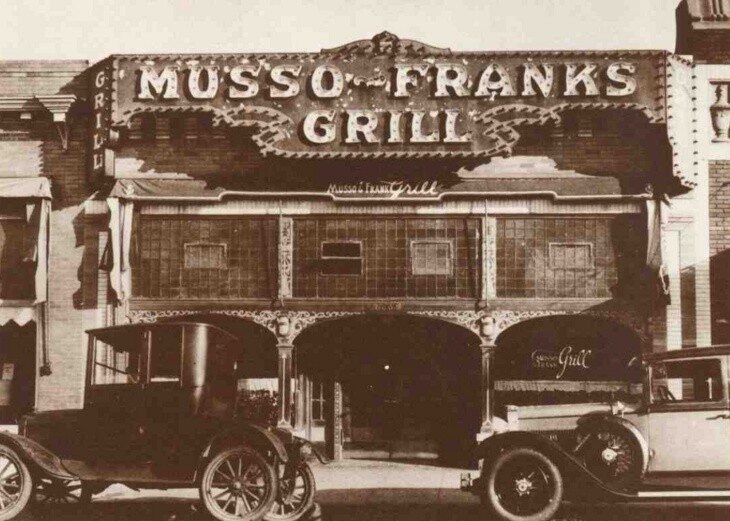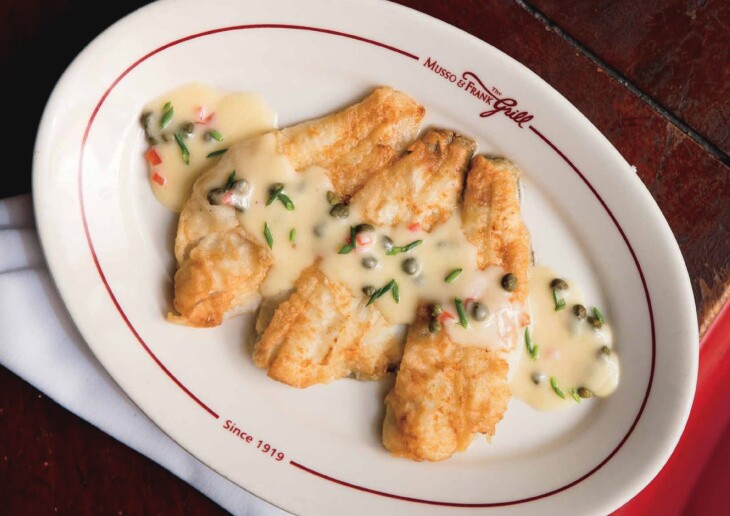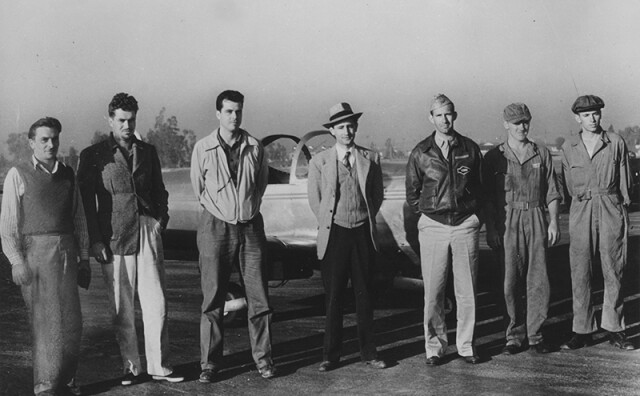The Weird And Wild Flavors Of Musso And Frank's Most Old Timey Dishes

Musso and Frank is about as vintage as a Los Angeles restaurant gets. At 100 years old, the nostalgic Hollywood joint still serves many of the same dishes it did in 1919, the year it opened. What goes well with late capitalism, environmental collapse and rising fascism? Maybe a side of creamed spinach.
"A steak house with international flavors," that's how chief operating officer Mark Echeverria describes Musso's. That's about right if we define "international" as European cuisine between 1800 and 1930.

Frank Toulet opened Frank's Café in 1919, just as Hollywood Boulevard was becoming the hippest strip in town. A few years later, Joseph Musso became his partner and in 1927, the restaurant became Musso and Frank. That same year, Joseph Carissimi and John Mosso (Echeverria's great grandfather) bought the outfit and moved it two doors down to its present location, at 6667 Hollywood Blvd.
The "new" Musso and Frank's boomed. Located next to the Stanley Rose Bookshop -- a literary salon, art gallery and makeshift bar haunted by the likes of Nathanael West and William Saroyan -- it became a spot where intellectuals could mingle with movie stars. Musso's was a favorite hang for writers such as William Faulkner, Dorothy Parker and F. Scott Fitzgerald as well as a home away from home for actors-turned-moguls Charlie Chaplin and Orson Welles, who said it was like "being in the womb."

Musso's first chef, Jean Rue, would work there for 53 years. During that time, he crafted a continental menu popular with café society and aspiring aristocrats. Staples included lamb chops, grenadine of beef and shrimp cocktail.
Over the decades, the menu expanded but Rue's recipes remained its stalwart. That's what regulars love about Musso's -- its continuity. The same food, the same martinis, the same bartenders, the same worn leather banquettes.
When Echeverria took over in 2009, he knew the menu needed some pruning, so he hired chef J.P. Amateau, who had eaten at the old wooden lunch counter as a child.
"J.P.'s got a rich personal history with the restaurant, which was, in my opinion, very crucial to how he approached the menu. He respected the traditions," Echeverria says.

Among the dozens of chefs he interviewed, Echeverria says Amateau was the only one who understood the importance of tradition. "Everybody kind of wanted to change things and make it their own. It's difficult to find that ego-less chef," Echeverria says.
His goal was to preserve Musso's classic dishes while making the menu more relevant.
As the 2008 recession buffeted the hospitality industry, Echeverria and Amateau considered what items they could cut.
"There were quite a few dishes that we had to really look at, as far as efficiency in the kitchen," Echeverria says. "We've got 150 items on the menu. The items that we took off really didn't have much historical significance. They were added here and there, like in the '70s and '80s, and didn't have much of a history with the restaurant."

Echeverria wouldn't say what dishes he ditched and we couldn't find an old menu but we know some old timey favorites were saved, like sauerbraten, a sour roast that involves marinating meat, usually in vinegar. The German dish, originally made with horse meat, was supposedly popularized by the emperor Charlemagne in the 9th century. Diplomat Pudding, a molded custard dessert allegedly first served in Hungary in 1908, also passed the test.
"We kept the lamb kidneys and bacon and, of course, the calf's liver, which actually is a very popular item. We kept the tongue sandwich. Those old school dishes really speak to when Musso's was originally open," Echeverria says.

Amateau gave the fare a subtle 21st century upgrade. He substituted fresh ingredients for canned ones, added seasoning and changed cooking methods. In some cases, he simply added salt.
"When you look at the tastebuds of the 1920s, they're a little bit different than the taste buds of today," Echeverria says. "Rarely did chefs back then season throughout the cooking process, which today we're accustomed to, so things were a little bit more bland."
Not everyone was pleased.

"At Musso's, we have the 'super regulars,' people who are here on the daily," Echeverria says. "If you change anything, even the polish you use for the wood floors, they'll notice. If the chef seasons it just a little bit more than he normally does, I'll probably hear about it. And people have also commented on dishes that we didn't change."
In slightly tweaking these recipes, Echeverria hopes that Angelenos of all ages can taste dishes that are, in some cases, centuries years old. In the new book The Musso & Frank Grill, author Michael Callahan chronicles the history of the restaurant and shares a few of its recipes. Some you'll recognize and love. Others, like the ones below, are rare enough that they might confound the modern palate.

Jellied Consommé
This savory brown jelly, eaten with a spoon, has been served at royal tables and in gourmet restaurants, like Delmonico's in New York City, for hundreds of years. By the turn of the 20th century, Vogue magazine was teaching middle-class hostesses how to make the perfect version of the dish. In 1901, they published this recipe:
To one can of prepared consommé soup add the pressed juice of a dozen boiled carrots and a bunch of parsley. Pour this over a half box of gelatin dissolved in water. Season with salt and a dash of red pepper, set on ice. When ready to serve, it should be of the consistency of wine jelly and should be served in bouillon cups. The strong flavor of the carrot gives piquancy to this bouillon and should not be omitted, as the gelatin weakens the flavor.
According to Echeverria, early 20th century restaurants like Musso's were able to cool refreshing gelatin thanks to their large kitchen iceboxes, a recent innovation.
"In the 1920s and in the '30s, before air conditioning was widely available to businesses, jellied consommé was offered sort of as an amuse- bouche. When you came in and sat down, you were served jellied consommé. It was intended to cool you down," he explains.
The POTUS was a fan. In 1925, the New York Times reported:
President and Mrs. Coolidge went to dinner early, eating alone... he a large two-inch broiled steak. Besides this he had a cup of jellied consommé and toasted raisin bread and hot coffee. Mrs. Coolidge ate more sparingly. Her meal consisted of jellied consommé, chicken salad and iced coffee.
Today, Musso's continues to serve jellied consommé made entirely in-house. "We have hot consommé on the menu every day and what hasn't been sold that night, we jelly that evening to have consommé the next day," Echeverria says. Take that, bone broth.

Flannel Cakes
The term "flannel cakes" was first recorded in the German novel Munchausen's Travels in 1792. According to food historian Joyce White, flannel cakes have taken the form of crumpets, buckwheat cakes, pancakes and bannocks. In 1878, Mrs. Carrie W. Hamlin of Detroit emphasized the flannel cake's importance to Michigan's French community during Mardi Gras celebrations:
Mardi Gras was one of unusual mirth and enjoyment with the easy-going, fun-loving habitants. The tossing of pancakes (flannel cakes)... was an old custom handed down, and even today is still observed... Each guest in turn would take hold of the pan with its long handle, while someone would pour in the thin batter barely enough to cover the bottom of the pan. The art consisted in trying to turn the cake by tossing it as high as possible and bringing it down without injuring the perfection of its shape. A deft and skillful hand was required, and many were the ringing peals of laughter that greeted a failure. The cakes were piled up in a pyramid shape, butter and maple sugar placed between each layer and formed the central dish in the substantial supper which took place later.
According to Echeverria, Rue added his version of flannel cakes to Musso's menu at some point between 1922 and 1925.
"They're sort of a cross between a thicker, heavier pancake and a really, really light crepe," Echeverria explains. "They are a very sweet dish but they're not quite as heavy and big as the pancake. They sit right in the middle."
Served plain, with fruit and yogurt or with whipped cream, the flannel cake was one of the few desserts initially offered at the restaurant. Echeverria describes it as "this perfect mix of a sweet dish that you could also eat for breakfast."

Welsh Rarebit
Usually offered as an appetizer, Welsh Rarebit is a European cheese-style fondue made with a healthy infusion of ale and served with toast points and slices of tomato and bacon.
Despite its name, the dish may or may not be Welsh but its origins seem to lie somewhere on the British Isles during the 17th century. According to Liverpool's Daily Post:
[It] is believed to have evolved through a traditional culinary practice of Welsh housewives, who, seeing that their husbands had returned empty handed from the hunt, would set a cheese in front of the fire to melt. The melted cheese would be eaten with bread after the meatless main course, in what was called a rearbit - similar to the way that hors d'oeuvres were known as forebits.
By the Victorian era, the rarebit had crossed the ocean, with the New York Times publishing several different recipes. In February of 1888, the San Francisco Chronicle reported on this "toothsome delicacy" so popular in British pubs:
There are in England several ancient inns, which are celebrated simply and entirely on account of the good old-fashioned rarebit they make. A traveler from across the water would naturally first strike to one at Liverpool called the "Taddle Hotel." Here he can enjoy an original rarebit. The simple recipe for a dish for four persons is as follows; One pound of good cheese melted thoroughly, to which is added one-half pint of beer and one tablespoon of dry mustard. This is placed on toast and the whole served on piping hot dishes.
Musso's version of rarebit, an early addition to the menu, was comfort food for the many British expats who had come to Hollywood to make their fortunes.
Echeverria thinks Rue's intention, in conceiving the restaurant's initial menu, was to incorporate flavors from all over Europe to appeal to people who were coming to Hollywood to work in the entertainment industry. "He wanted to create something familiar to them and I think this was a dish that the Welsh, the Scottish and even by the English would notice on the menu and order."

Lobster Thermidor
This decadent French entrée usually involves lobster, brandy and egg baked in a lobster shell and covered in cheese. It's the perfect meal after you've scored a big screenwriting deal and have wads of cash to throw around.
The dish's origins may stretch back to 1891, according to A Curious History of Food and Drink:
Victorien Sardou's play Thermidor (named after one of the months in the French revolutionary calendar) had its premiere at the Comedie-Francaise in Paris. The story, set during the Reign of Terror, tells how an actor saves the lives of many potential victims by infiltrating the committee of Public Safety and destroying their files. Having heard that the play was critical of their hero Maximilien Robespierre, radical republicans crowded to the second performance and nearly caused a riot, prompting the intervention of the police... The play was subsequently banned by the government from all state-funded venues. However, Thermidor did give rise to a new dish, named in its honor by its creator, Tony Girod, the chef at Café de Paris. This was the luxurious lobster thermidor.

The Original Fettuccini Alfredo
The original version of this dish was supposedly brought from Italy directly to Musso's. According to legend, in the 1920s, Hollywood superstars Mary Pickford and Douglas Fairbanks visited Rome and dined at the restaurant of Alfredo di Lelio, known as "Il Maestro." He served his famous dish, "pasta al burro." Writer Todd Coleman explains:
As the story goes, after di Lelio's wife gave birth to their son, she lost her appetite. Di Lelio, determined to get her to eat, transformed his fettuccine al burro -- a homely preparation of pasta tossed with butter and parmesan -- by increasing significantly the amount of butter he used. The result was a more lavish dish, which neither his wife nor his customers could resist.
Pickford and Fairbanks were also enamored with the dish, so much so that they presented Alfredo with a golden fork and spoon and begged him for the recipe. He agreed to give it to them and they brought it back to chef Rue.
Rue would often make it for the duo but the pasta dish wasn't added to the menu until years later, when it appeared as Fettuccini Alfredo. Unlike the alfredo most Americans are used to, Musso's stays true to the Italian original. It uses no cream and much less cheese than most modern versions but it's just as carby and comforting.
-
Restored with care, the 120-year-old movie theater is now ready for its closeup.
-
Councilmember Traci Park, who introduced the motion, said if the council failed to act on Friday, the home could be lost as early as the afternoon.
-
Hurricane Hilary is poised to dump several inches of rain on L.A. this weekend. It could also go down in history as the first tropical storm to make landfall here since 1939.
-
Shop owners got 30-day notices to vacate this week but said the new owners reached out to extend that another 30 days. This comes after its weekly swap meet permanently shut down earlier this month.
-
A local history about the extraordinary lives of a generation of female daredevils.
-
LAist's new podcast LA Made: Blood Sweat & Rockets explores the history of Pasadena's Jet Propulsion Lab, co-founder Jack Parsons' interest in the occult and the creepy local lore of Devil's Gate Dam.









